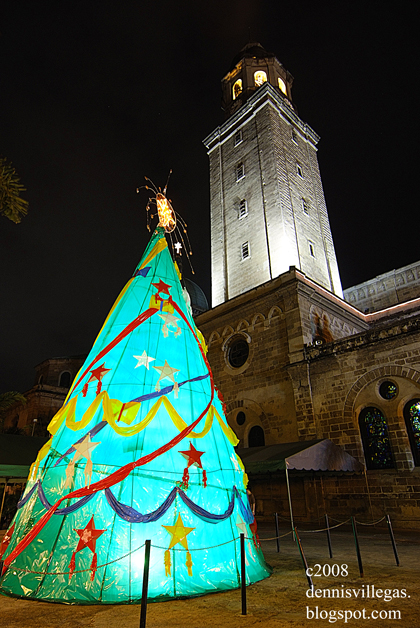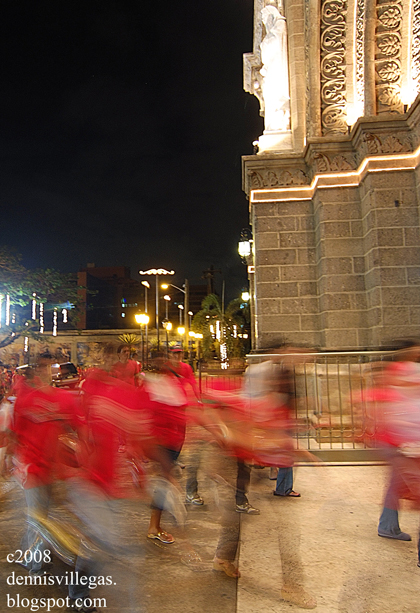Happy New Year to all my fellow bloggers and readers! May the Lord bring us tidings of prosperity, health and happiness all year-round and for all the years to come.
Wednesday, December 31, 2008
Bill O'Reilly
I was thinking about the best way to celebrate Bill O'Reilly signing a new contract that will keep him on television for the next four years. He'll get paid $10,000,000 a year just for his doing his "O'Reilly Factor" show.
The only thing that I think would be a satisfactory tribute to the man himself, would include introducing you to "Lil' O'Reilly". The kid does a spot on impression of the bigoted bag of hot air.
The only thing that I think would be a satisfactory tribute to the man himself, would include introducing you to "Lil' O'Reilly". The kid does a spot on impression of the bigoted bag of hot air.
Tuesday, December 30, 2008
Upcoming Molecular Imaging Conference- Annoucement

This may be the single most important event this year for your radiology practice and pathology group. The Molecular Summit on February 10th – 11th 2009 in Philiadelphia is the most exciting intersection of genomic technologies in medicine today! Innovators are pushing forward to integrate molecular imaging and molecular diagnostics in ways that shift current paradigms in patient care and Molecular Summit brings all the key players together at one time and one place.
Contact
Justin M. Clark
E-mail: JClark@DarkReport.com
Monday, December 29, 2008
New Year's Eve Scenes in Downtown Manila
The recent survey conducted by the Social Weather Stations revealed that about 92 percent of Filipinos have a bright hope for the incoming year, this despite the many drawbacks that the Philippines had experienced in 2008. It's just one of those positive things that we Filipinos are known for. In the face of the dark odds we know how to look towards the brighter side of things. It is also the same way we tend to look at a glass half-filled with water--we look at it as half-full rather than half-empty.
Meantime I made a round of downtown today to bring you the fresh images of what is happening in Manila two days before the coming New Year. As usual it is very crowded in downtown Manila as many Filipinos prepare to welcome 2009, the Year of the Ox, in the Chinese Calendar.
(Images may take time to download so have a sip of hot coffee first before viewing the pictures ;-)
Meantime I made a round of downtown today to bring you the fresh images of what is happening in Manila two days before the coming New Year. As usual it is very crowded in downtown Manila as many Filipinos prepare to welcome 2009, the Year of the Ox, in the Chinese Calendar.
(Images may take time to download so have a sip of hot coffee first before viewing the pictures ;-)

Lebertad!! Lebertad, Ah sakay na kayo sa Lebertad!!! (The correct spelling should be Libertad)

Avenida Rizal Bangketa

The inventiveness of Pinoys: A rolling Sari-sari Store

Tikoy for Sale! Large-70, Medium-40, Small-35

Selling Fishballs, Squidballs (Huh since when did squids and fishes have balls?), Tukneneng, Kwekwek, Kutsinta
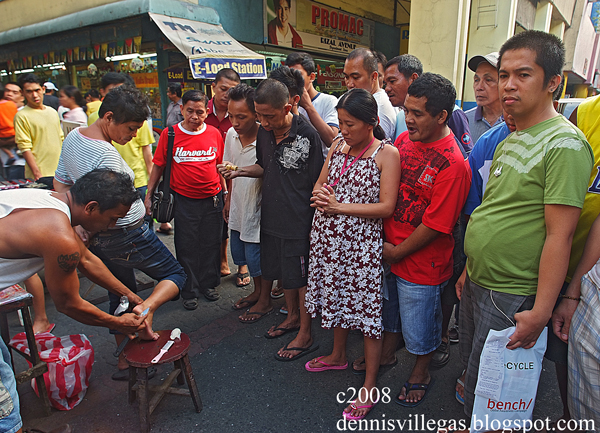
Vendor demonstrating the effectiveness of his Souhed potion to remove the warts and dead skins
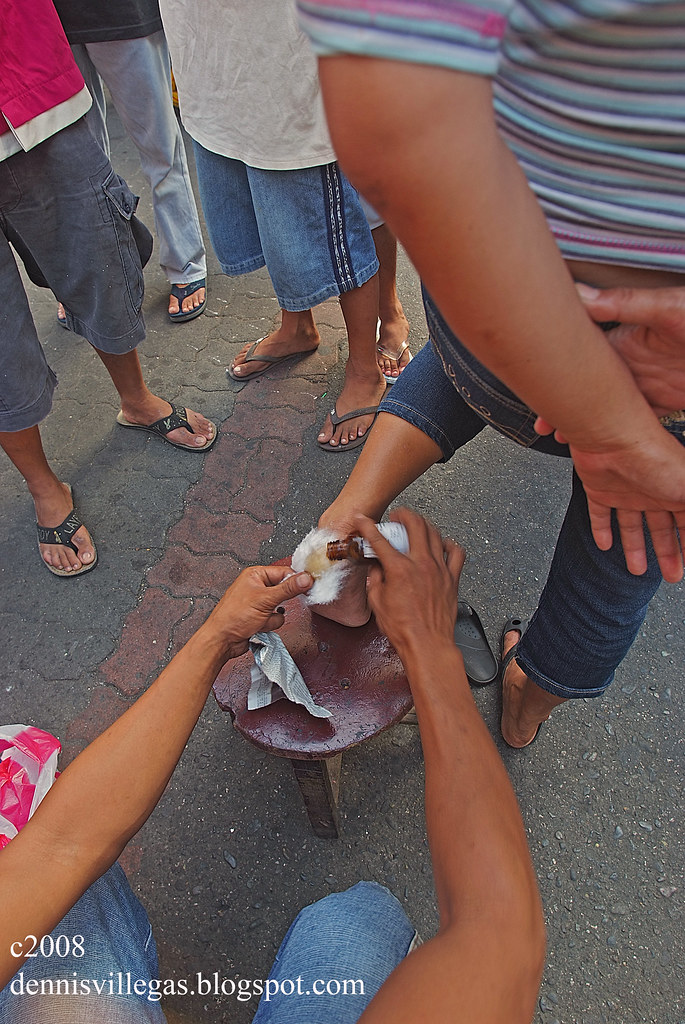
Only 35 pesos per small bottle.
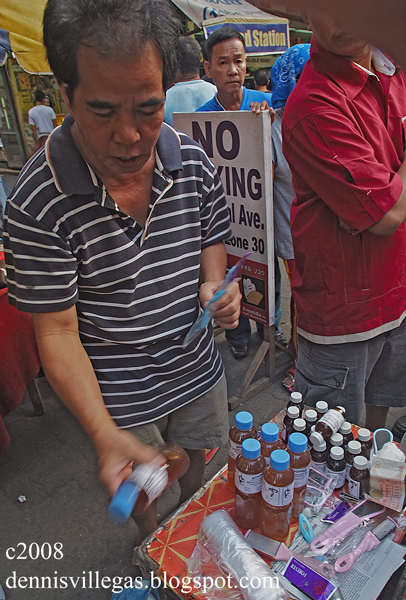
After the demo, it's selling time! 70 large bottle, 35 small bottle. I bought 1 small bottle to poison rats

Torotot

Buko Seller

Cakes seller

Hamburger Buy 1 Take 1 for only 20 pesos
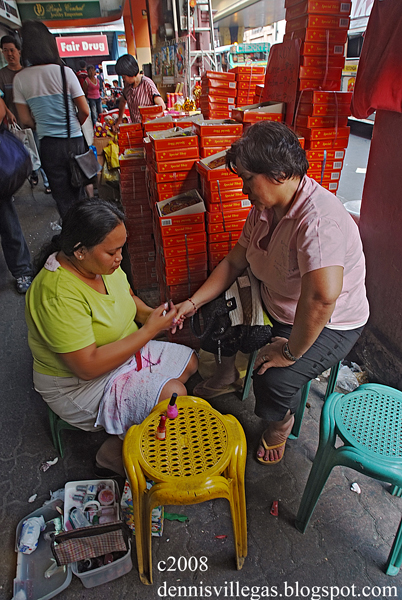
Sidewalk Manicure and Pedicure (Manicure 35, Pedicure, 35). I used to be a pederast before, but after having my nails and toes cleaned, I've been pedicured!
Schwannomatosis
Findings
Figure 1, Figure 2, and Figure 3: Sagittal T2 and post contrast sagittal T1 weighted images demonstrate numerous enhancing intradural, extramedullary masses lining the roots of the cauda equina.
Figure 4, Figure 5, and Figure 6: A heterogeneously enhancing right paraspinal mass demonstrates heterogenous signal on T2 weighted images, highly suggestive of a schwannoma. There is no adjacent osseous erosion.
Diagnosis: Schwannomatosis
Schwannomatosis is a form of neurofibromatosis that has unique diagnostic criteria but can have findings that overlap with other forms of NF that can confound diagnosis.
Spectrum of neurofibromatosis:
- Neurofibromatosis Type I: Café au lait spots, skin fold freckling, Lisch nodules, cutaneous and plexiform neurofibromas, learning disabilities, and propensity for malignancy
- Neurofibromatosis Type II: Bilateral vestibular schwannomas, various other intracranial, spinal and cutaneous schwannomas, meningiomas, ependymomas. Ocular manifestations include cataract, retinal hamartoma
- Schwannomatosis: Schwannomas in multiple locations without the presence of vestibular schwannomas
Schwannomatosis, also known as neurilemmomatosis, is a condition of multiple non-vestibular schwannomas in a patient who has no other stigmata of neurofibromatosis type 2. Schwannomas are benign nerve sheath tumors that are usually solitary and occur sporadically. A definite diagnosis of schwannomatosis can be made when a patient older than 30 years has two or more nondermal schwannomas, one of which has been pathologically confirmed. There is however, a wide spectrum of overlap between schwannomatosis and NF2 such that a definitive diagnosis may be difficult to make.
Differences between schwannomatosis and NF2 include the age of presentation. Most patients with the former will present in middle age, whereas patients with NF2 present in the second to third decade of life. Patients with schwannomatosis generally do not have a corresponding family history, unlike NF2.
Imaging characteristics of the tumors in schwannomatosis are the same as those of sporadic schwannomas. Iso/hypointensity on T1 weighted images, hyperintensity (secondary to cystic change, and occasionally hemorrhage) on T2 weighted and STIR images and avid contrast enhancement are typical findings.
Dedicated imaging of the internal auditory canals and the brain should be pursued to help clarify the diagnosis. Follow up imaging is also indicated, especially if the diagnosis is not definitive, as malignant degeneration of an NF2 lesion would manifest as rapid increase in size of a mass.
Superior Saggital Sinus Thrombosis-MRI




These are MRI images of superior sagital thrombosis note the high signal in the sinus in the axial images and thrombosis seen on the MR venogram.
Dr.Sumer K Sethi, MD
Sr Consultant Radiologist ,VIMHANS and CEO-Teleradiology Providers
Rotator Cuff Tear-MRI
Saturday, December 27, 2008
The Story of Elyn May Lorempo
Elyn May Lorempo looks like a little infant being cradled by her mother on the stairs of the Hidalgo side of the Quiapo underpass. In truth, Elyn May is already four years old but her body is that of an infant girl. Elyn May suffers from holoprosencephaly, a serious and life-threathening defect of the brain. Her mother, Aling Arlene, brings her to Quiapo underpass every Friday and Sunday, to beg for money for the numerous medications that Elyn May needed everyday.
I happened to pass by them after I attended the last Friday Mass in Quiapo. I was moved to pity finding such a cute little girl suffering from a grave illness. I always give something to poor people, whenever I can with what little earnings I make. Yet, I thought that I was never happier than when I gave some money to little Elyn May. I wanted to help in my own little way, for her medications.
I was very touched at the situation of this mother and child, that I decided to learn a little bit about their story. I found that they originally came from Capiz. Elyn May has a father who works in a farm as a day-laborer. She has five siblings. The family is very poor.
When Elyn May was born, the doctors thought that she will soon die. The baby could not breath properly because of her inborn defect in the mouth and nose. Her cleft palate was open, and every time she was breast fed, the milk dangerously lodged into her lungs, collapsing them. She was very very small and weak, and she developed pnuemonia-- a killer disease among newborns. As if all of these tragedies were not enough, the doctors announced that she had holoprosencephaly, a degenerative disease without cure.
A year ago, Aling Arlene brought her daughter to Manila, to seek better medical help. Through the help of neighbors and friends, they were able to raise money for a transportation cost. The father did not accompany them as he must work to support the other five children.
Once in Manila, Aling Arlene sought the help of charities, literally begging from strangers. Some people took pity and gave donations to give the child a fighting chance. But even the specialists in Manila could do nothing to cure the child. Indeed, her condition was degenerative--everything was going downhill. Only palliative care was offered by the doctors.
Elyn May is also severely epileptic. During my short interview with her mother, she had numerous episodes of seizures. A sign that she was having an attack was when she rolls her eyes upwards, her frail body stiffens, and her mouth begins to froth. Her mother never panics when such attacks occur. She just wipes her daughter's mouth with a towel and massages her little frail body.
I asked Aling Arlene if I can hold her child in my arms. It was a brave proposal because I knew it was a sort of personal invasion to her already small space. But she gladly agreed. I was surprised that Elyn May was so light, really just like a little baby, despite her being already four years old.
I was very touched at the situation of this mother and child, that I decided to learn a little bit about their story. I found that they originally came from Capiz. Elyn May has a father who works in a farm as a day-laborer. She has five siblings. The family is very poor.
When Elyn May was born, the doctors thought that she will soon die. The baby could not breath properly because of her inborn defect in the mouth and nose. Her cleft palate was open, and every time she was breast fed, the milk dangerously lodged into her lungs, collapsing them. She was very very small and weak, and she developed pnuemonia-- a killer disease among newborns. As if all of these tragedies were not enough, the doctors announced that she had holoprosencephaly, a degenerative disease without cure.
A year ago, Aling Arlene brought her daughter to Manila, to seek better medical help. Through the help of neighbors and friends, they were able to raise money for a transportation cost. The father did not accompany them as he must work to support the other five children.
Once in Manila, Aling Arlene sought the help of charities, literally begging from strangers. Some people took pity and gave donations to give the child a fighting chance. But even the specialists in Manila could do nothing to cure the child. Indeed, her condition was degenerative--everything was going downhill. Only palliative care was offered by the doctors.
Elyn May is also severely epileptic. During my short interview with her mother, she had numerous episodes of seizures. A sign that she was having an attack was when she rolls her eyes upwards, her frail body stiffens, and her mouth begins to froth. Her mother never panics when such attacks occur. She just wipes her daughter's mouth with a towel and massages her little frail body.
I asked Aling Arlene if I can hold her child in my arms. It was a brave proposal because I knew it was a sort of personal invasion to her already small space. But she gladly agreed. I was surprised that Elyn May was so light, really just like a little baby, despite her being already four years old.
She has a protruding head, a cleft lip and palate, and-- I noticed, she didn't have a nose. She was breathing through her mouth. A little thin hose is inserted in a little opening in a hole in her missing nose. She was being fed through the tube that goes all the way to her little stomach.
While holding her tenderly in my arms, I began talking with her, telling her how pretty and brave she was. Yet, I know her damaged brain could not understand me and her surroundings. Her hands were so tender and frail, her head so small. I found that she was paralyzed. She could not move her hands, feet, and head. The only sign that she was still living was her labored breathing, and her ever open eyes--her small eyeballs sometimes moving from side to side.
The doctors told me to be ready because anytime, she might die" says Aling Arlene. Yet, looking through Elyn May's eyes, I could see a determination to survive. I could not understand it, but I felt it.
Meantime, a few people fresh from the friday Mass were already beginning to flock to see the little child. Some of them gave 20, 50, and one 100. A woman gave a glimpse, touched her purse, but walked away. I knew that she wanted to give, only she may not have the money that time. I was glad that many people still have hearts of gold to reach out for the poor.
It was already getting dark, and I had to bid goodbye to my new-found friends--Aling Arlene and Elyn May. Aling Arlene was teary-eyed that many people shared something to them. I knew she had shed many tears before, and more in the future. I could see her determination to let her child live. She had not slept for whole nights, eschewed personal needs as luxury, and must indefinitely withhold grief, to give way to the needs of her beloved daughter.
While holding her tenderly in my arms, I began talking with her, telling her how pretty and brave she was. Yet, I know her damaged brain could not understand me and her surroundings. Her hands were so tender and frail, her head so small. I found that she was paralyzed. She could not move her hands, feet, and head. The only sign that she was still living was her labored breathing, and her ever open eyes--her small eyeballs sometimes moving from side to side.
The doctors told me to be ready because anytime, she might die" says Aling Arlene. Yet, looking through Elyn May's eyes, I could see a determination to survive. I could not understand it, but I felt it.
Meantime, a few people fresh from the friday Mass were already beginning to flock to see the little child. Some of them gave 20, 50, and one 100. A woman gave a glimpse, touched her purse, but walked away. I knew that she wanted to give, only she may not have the money that time. I was glad that many people still have hearts of gold to reach out for the poor.
It was already getting dark, and I had to bid goodbye to my new-found friends--Aling Arlene and Elyn May. Aling Arlene was teary-eyed that many people shared something to them. I knew she had shed many tears before, and more in the future. I could see her determination to let her child live. She had not slept for whole nights, eschewed personal needs as luxury, and must indefinitely withhold grief, to give way to the needs of her beloved daughter.
I can understand her loneliness. And I knew she needs our compassion. But for me Aling Arlene is a true tragic heroine, for only she knows the special agony and sufferings exclusively reserved for mothers of terminally ill children.
Friday, December 26, 2008
Radiology Post Tsunami
"Found this interesting article in Emergency Radiology describing radiological findings in tsunami victims. Most common findings were trauma involved musculoskeleton, retained foreign bodies in soft tissues, pneumonia/aspiration, and tsunami sinusitis."
Reference-
Wednesday, December 24, 2008
Merry Christmas from Cubao, Philippines!
May the Good Lord Bless You and Your Loved Ones now and always. Merry Christmas!
Araneta Center Cubao's Giant Christmas Tree
Tuesday, December 23, 2008
Brain abscess secondary to frontal osteoma and sinusitis
Findings
CT demonstrates a well marginated bone density lesion arising from the anterior left frontal sinus wall and protruding into the sinus lumen (Figure 1). Opacification is present in the superior left frontal sinus consistent with sinusitis (Figure 1). The posterior left frontal sinus wall is dehiscent (Figure 2).
MR demonstrates a multilocular ring enhancing process in the left anterior frontal lobe (Figure 1 and Figure 2). The center of the collection demonstrates high signal on diffusion weighted images (yellow arrows in Figure 6 and Figure 7). The overlying dura enhances as does the adjacent frontal sinus (Figure 4 and Figure 5). Vasogenic edema is present in the surrounding left frontal white matter (Figure 2 and Figure 3).
Diagnosis: Brain abscess secondary to frontal osteoma and sinusitis
Brain abscess is an infectious process which results in high morbidity and mortality if undiagnosed and untreated. In today’s era of antibiotics and refined neurosurgical technique, the major obstacle to successful treatment is delayed diagnosis. Noninvasive diagnostic imaging is critical for diagnosis and is directly responsible for improved patient outcomes in the last 10-15 years.
Brain abscess presents as a rapid developing space occupying syndrome usually beginning with a headache, followed by focal neurological deficit or seizure, and may progress to increased intracranial pressure, nausea,vomiting, and loss of consciousness. Fever is absent in 50% of cases as in this case.
Infection occurs by extension from a direct cranial focus or by hematogenous dissemination from an extracranial source with 50% incidence of each. Mastoiditis is the most common cranial source (30%) followed by sinusitis (15%). Hematogenous seeding accounts for 25%, of which endocarditis is the most common cause. No identified cause is found in 20% of cases. Rare causes include retrograde thrombophlebitis from a facial or dental infection, penetrating trauma, meningitis complication, and surgery.
The typical appearance of brain abscess on CT is a focal round lesion with hypodense center and surrounding vasogenic edema. If contrast is given, ring enhancement is seen. Abscess secondary to mastoiditis occurs in the temporal lobe and sometimes the posterior cranial fossa. Paranasal sinusitis results in frontal lobe location, and hematogenous dissemination usually results in multiple lesions following a vascular distribution.
On MRI, brain abscess demonstrates ring enhancement. Compared to other ring enhancing lesions, abscesses exhibit thinner, more regular, and more homogenously enhancing walls. Often, the cortical wall will be thinner. Classically, the lesion will have a T2 hypointense rim. A critical finding usually seen is central restricted diffusion corresponding to the infection products. Necrotic tumors seldom demonstrate restricted diffusion within the necrotic center. A dominant lesion will often demonstrate contiguous smaller satellite lesions. Another helpful finding is surrounding vasogenic edema which invariably is seen with abscess and neoplasm and rarely seen in other ring enhancing or restricted diffusion lesions such as demyelinating lesions. Lymphoma can be a difficult differential diagnosis as lymphoma usually restricts diffusion, causes vasogenic edema, ring enhances, and can have central necrosis. Clinical history of immunocompromise and location are occasionally helpful to differentiate from abscess.
This patient’s frontal sinus osteoma contributed to the frontal sinusitis and/or intracranial extension of the infection. Paranasal sinus osteomas are benign, asymptomatic bone growths that can rarely have intracranial complications including subdural empyema, abscess, CSF leak, and pneumocephalus. Osteomas demonstrate variable ossification from dense ivory type to a more ground glass appearance.
Post Traumatic Wrist MRI


Controversy surround the etiology of kienboecks disease (lunatomalacia).
Few of the theories are (a) In manual workers chronic repetitive trauma is considered to damage supplying arteries of the lunate . : Arteries entering the lunate from the dorsal and palmar pole form an intraosseous vascular network with the proximal pole supplied by terminal arteries only . (b)Another theory of compression or avulsion fractures as the primary cause of lunatomalacia is nowadays rejected by many authors. (c)According to an observation by Hulten , lunatomalacia is associated with a negative ulnar variance in 78% of the test population. Due to inadequate force transmission from the ulna to the wrist, the lunate is exposed to an increased axial load in the radiolunate articular cornpartnient. (d)Most recently, the possibility of venous congestion is discussed as a cause of lunatomalacia with intraosseous measurements showing significantly higher pressures .
MRI Staging with signal on T1
Stage 1- Low signal, and shows homogenous enhancement refd as edema considered as prognostically good
2-Low signal on T1 shows pathcy inhomogenous enhancement and is refd as partial necrosis
3-Low signal on T1 absent enhancement and refd as complete necrosis
Differential diagnosis includes the rare fractures of the lunate without consecutive necrosis, the ulnolunar impaction syndrome, and intraosseous ganglia originating from the scapholunar or lunotriquetral ligament
Staging classification of Kienbock's disease on radiological and MRI criteria.Stage (MRI and conventional radiography) Lichtman and Ross
I Normal radiographic appearance,diagnosis by MRI
II Increased spongiosal sclerosis,initial fracture of the proximal pole possible
III (a) Lunate collapse without carpal instabilityIII (b) Progessive lunate collapse with carpal instability
IV Progessive carpal collapse and ostcoarthritis (SLAC wrist) in our case proximal pole of scaphoid shows the fracture but marrow signal is normal and no AVN is seen.
Case by Dr MGK Murthy, Sr Consultant Radiologist
Monday, December 22, 2008
The Manila Cathedral's Misa de Gallo
The sights at the Misa de Gallo in Manila Cathedral are quite a world away from the sights of Misa de Gallo at Quiapo Church. The Quiapo Church, with its ambiance of congestion and noise, is ever crowded with people from all walks of life, coming and going--pedestrians, vendors, devotees, and passers-bys.
The Manila Cathedral, on the other hand, exudes a more regal ambience- uncrowded, air-conditioned, and majestically lighted. At night, the Manila Cathedral's lights are ever more beautiful, a testament to it's standing as the country's premier cathedral. For me, the cathedral's hushed environment is admirable, but deep inside, I longed for the more populated Quiapo ambience.
After the Mass, I went around to look for some bibingka and puto bumbong, but I couldn't find any kiosks near the cathedral's vicinity. As it happened, the only bibingka kiosk inside the Intramuros premises was located in the Ilustrado restaurant some blocks away. I wonder why no one had thought of putting up bibingka kiosks near the cathedral. It has always been customary for church-goers to have a breakfast of bibingka, puto bumbong, or suman after the Misa de Gallo. In comparison, Quiapo has numerous such kiosks, competing to sell their best bibingkas and salabats (ginger tea) to the church-goers.
I also took some pictures of the cathedral for my ever-increasing collection of church photographs. I forgot my tripod, and so all the pictures were either shot hand-held at very high isos, or I just anchored my arms on a tree or some solid structure. Afterwards, I drove to downtown Quiapo to have a breakfast of bibingka and salabat.
Meantime here are some of the images of the Manila Cathedral I fancied to photograph. What a grand cathedral it is. I hope you will enjoy looking at them as much as I enjoyed photographing them.
Merry Christmas!
The Manila Cathedral, on the other hand, exudes a more regal ambience- uncrowded, air-conditioned, and majestically lighted. At night, the Manila Cathedral's lights are ever more beautiful, a testament to it's standing as the country's premier cathedral. For me, the cathedral's hushed environment is admirable, but deep inside, I longed for the more populated Quiapo ambience.
After the Mass, I went around to look for some bibingka and puto bumbong, but I couldn't find any kiosks near the cathedral's vicinity. As it happened, the only bibingka kiosk inside the Intramuros premises was located in the Ilustrado restaurant some blocks away. I wonder why no one had thought of putting up bibingka kiosks near the cathedral. It has always been customary for church-goers to have a breakfast of bibingka, puto bumbong, or suman after the Misa de Gallo. In comparison, Quiapo has numerous such kiosks, competing to sell their best bibingkas and salabats (ginger tea) to the church-goers.
I also took some pictures of the cathedral for my ever-increasing collection of church photographs. I forgot my tripod, and so all the pictures were either shot hand-held at very high isos, or I just anchored my arms on a tree or some solid structure. Afterwards, I drove to downtown Quiapo to have a breakfast of bibingka and salabat.
Meantime here are some of the images of the Manila Cathedral I fancied to photograph. What a grand cathedral it is. I hope you will enjoy looking at them as much as I enjoyed photographing them.
Merry Christmas!
Philippine Christmas Traditions
My collection of old pictures of Philippine Christmas Traditions, depicting scenes from the 1960s. These old pictures have been with our family for as long as I can remember. I especially dedicate this post to my online Filipino friends now living abroad. I'm sure they miss the uniqueness of Philippine Christmas, and I hope that my articles and images of Philippine Christmas will somehow bring them home, at least by looking at these pictures.
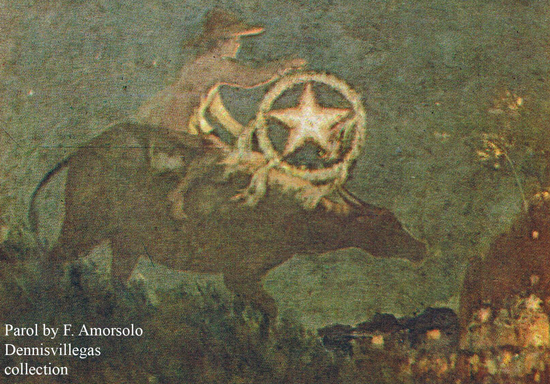
A beautiful Fernando Amorsolo painting depicting a rural Philippine Christmas

The Parol symbolizing the Star of Bethlehem
that guided the Magi to their journey to the Child Jesus
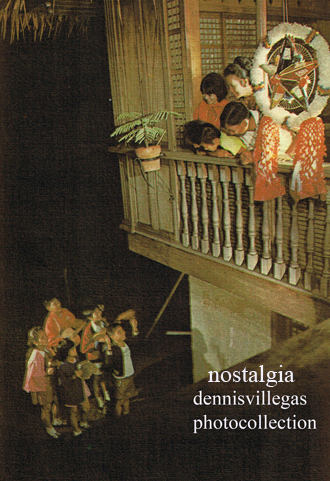
Karoling, a local version of a Christmas Carol.
The Karoling traditionally starts at December 16.
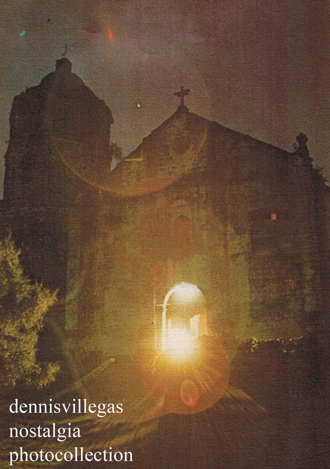
Simbang Gabi or Misa de Gallo (Rooster's Mass), also starts
on December 16 and up to December 24, nine days of early morning mass.

Simbang Gabi is usually capped off with a breakfast of
Bibingka, Puto Bumbong, Suman, and Salabat.
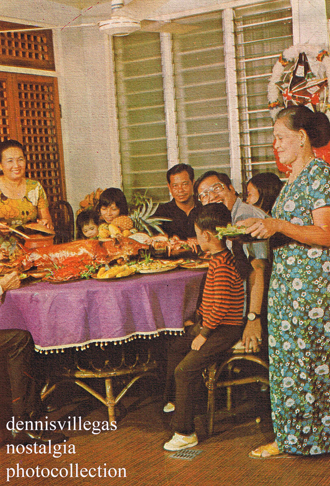
Noche Buena, the Family feast on Midnight of
Decemebr 24, a celebration of Child Jesus' nativity.
(The pictures are copyright of the Villegas library collection, Manila Philippines))
Subscribe to:
Posts (Atom)











